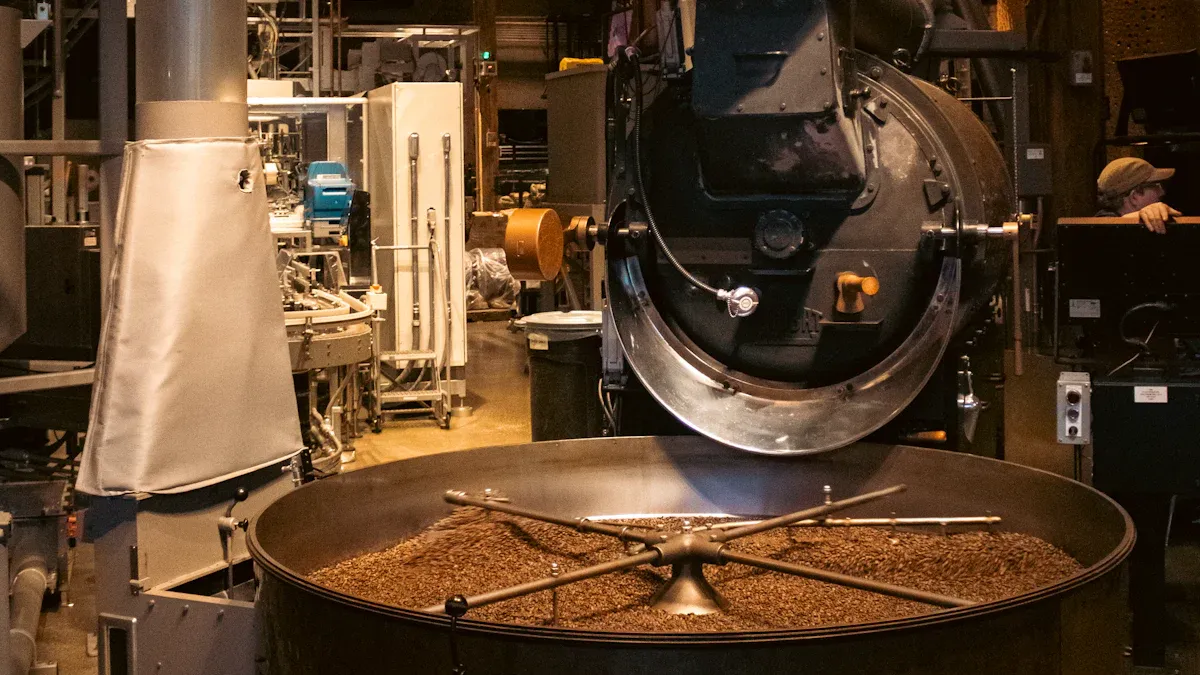
Scaling production is essential when you want to meet growing market demands and expand your business. Efficiently moving from prototyping to full-scale production ensures your product is ready for mass manufacturing without delays. Prototype injection molding plays a crucial role in this process. It allows you to refine your design, test functionality, and identify potential issues early. By addressing these challenges, you reduce risks and create a smoother path for large-scale manufacturing. Injection and molding techniques also help you achieve consistent quality while keeping production costs under control.
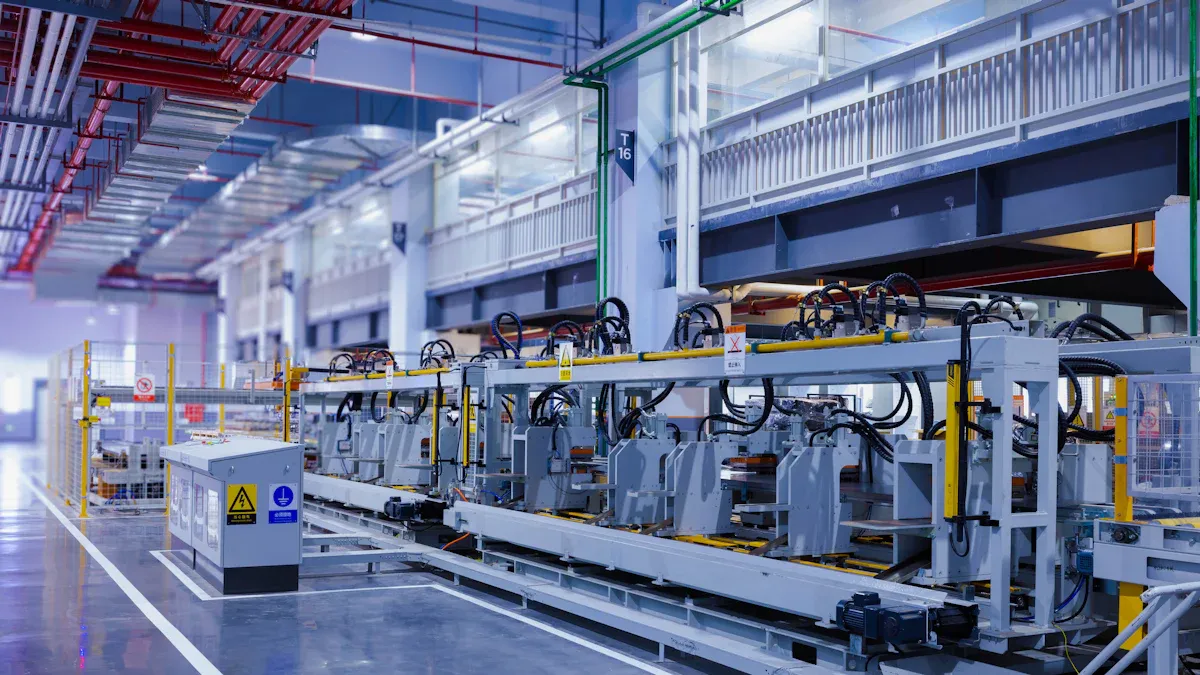
Prototypes serve as the foundation for refining your product before moving to large-scale production. They allow you to test designs, functionality, and usability. Prototype injection molding is a key process in this stage. It enables you to create tangible or digital models quickly, depending on your design goals. This method evaluates design changes, verifies construction documentation, and assesses technical feasibility. It is particularly effective for producing plastic parts in small batches, offering a fast and cost-efficient way to refine your product.
By using prototype injection molding, you can identify and fix design flaws early. This saves time and money during the manufacturing scale-up process. Additionally, prototyping enhances your product's quality and boosts your brand image, making it a valuable investment for any business.
Scaling production introduces several challenges that require careful planning. One major hurdle is maintaining efficiency while increasing output. For example, scaling manufacturing often impacts workforce productivity and cash flow. Metrics like revenue per employee and working capital efficiency help monitor these factors. Another challenge involves ensuring profitability. Break-even analysis becomes crucial to determine the production volume needed for success.
Additionally, scaling manufacturing can strain resources, leading to potential delays or quality issues. Addressing these challenges early ensures a smoother transition to full-scale manufacturing.
| Metric | Description |
|---|---|
| Revenue per Employee | Evaluates improvements in workforce efficiency resulting from scaling. |
| Contribution Margin Ratio | Indicates profitability improvements from scaling by considering variable costs against revenue. |
| Working Capital Efficiency | Monitors cash conversion cycle to ensure scaling investments don’t negatively impact liquidity. |
| Break-Even Analysis | Determines production volume required for profitability at different scaling stages. |
Transitioning to full-scale manufacturing offers numerous advantages. It reduces costs through optimized inventory management and minimizes material waste. For instance, businesses have reported annual savings of $13.8 million from reduced waste. Full-scale production also improves scheduling accuracy and equipment effectiveness, leading to faster response times during supply chain disruptions.
Moreover, large-scale manufacturing enhances product quality. Companies have seen a 27% reduction in warranty claims and a 15-25% decrease in quality deviations. These improvements not only save money but also strengthen customer trust. Faster product introduction cycles, ranging from 30-50%, further highlight the benefits of scaling production effectively.
| Benefit Description | Numerical Outcome |
|---|---|
| Reduction in quality-related warranty claims | 27% |
| Improvement in production scheduling accuracy | 32% |
| Annual savings from optimized parts inventory | $47 million |
| Faster response to supply chain disruptions | 62% |
| Increase in successful batch completion rate | 22% |
| Reduction in quality testing time | 35% |
| Annual savings from reduced material waste | $13.8 million |
| Improvement in Overall Equipment Effectiveness (OEE) | 12-18% |
| Reduction in inventory carrying costs | 20-30% |
| Faster new product introduction cycles | 30-50% |
| Decrease in quality deviations | 15-25% |
Refining injection mold-ready designs is a critical step in transitioning from prototyping to full-scale manufacturing. You need to ensure your designs are optimized for the injection molding process to avoid costly errors during production. Start by simplifying complex features in your part design. This makes the manufacturing scale-up process more efficient and reduces production risks.
Using vacuum casting can help you create prototypes that closely resemble the final product. This allows you to evaluate aspects like fit, functionality, and user experience. Before committing to expensive tooling, test a high-quality prototype to identify and fix design flaws early. Seeking feedback from mentors or industry experts on your 3D designs can also help you align your product with market needs.
Market research is another valuable tool. By gathering consumer insights on pricing, features, and value, you can refine your injection mold-ready designs to meet customer expectations. These steps not only improve efficiency but also minimize risks when scaling up production.
Choosing the right materials is essential for balancing durability and cost efficiency in large-scale production. Materials should meet the performance requirements of your product while keeping costs under control. For example, selecting cost-effective plastics for injection molding can significantly reduce expenses without compromising quality.
Collaborate with suppliers to ensure the availability of materials that meet your specifications. This step helps you avoid delays during manufacturing scale-up. Additionally, consider the environmental impact of your material choices. Sustainable materials not only appeal to eco-conscious consumers but also reduce waste during production.
Thorough testing of materials is crucial. Conduct stress and strain tests to evaluate durability under real-world conditions. This ensures your product performs reliably over time. By selecting the right materials, you can achieve a balance between cost, quality, and sustainability.
High-quality injection molds are the backbone of successful full-scale manufacturing. To create molds that deliver consistent results, focus on precision and durability. Dimensional accuracy is key. It ensures your molds produce parts that match the design specifications.
Testing your molds is equally important. Evaluate performance indicators like surface quality, mechanical properties, and thermal stability. For example, surface quality impacts the appearance and coating of your product, while thermal stability ensures consistent performance under varying temperatures.
Implementing a small production run can help validate the quality of your molds. This step allows you to identify and address any issues before scaling manufacturing to full capacity. Additionally, monitor production metrics like defect rates and cycle times to ensure your molds maintain efficiency and consistency during large-scale production.
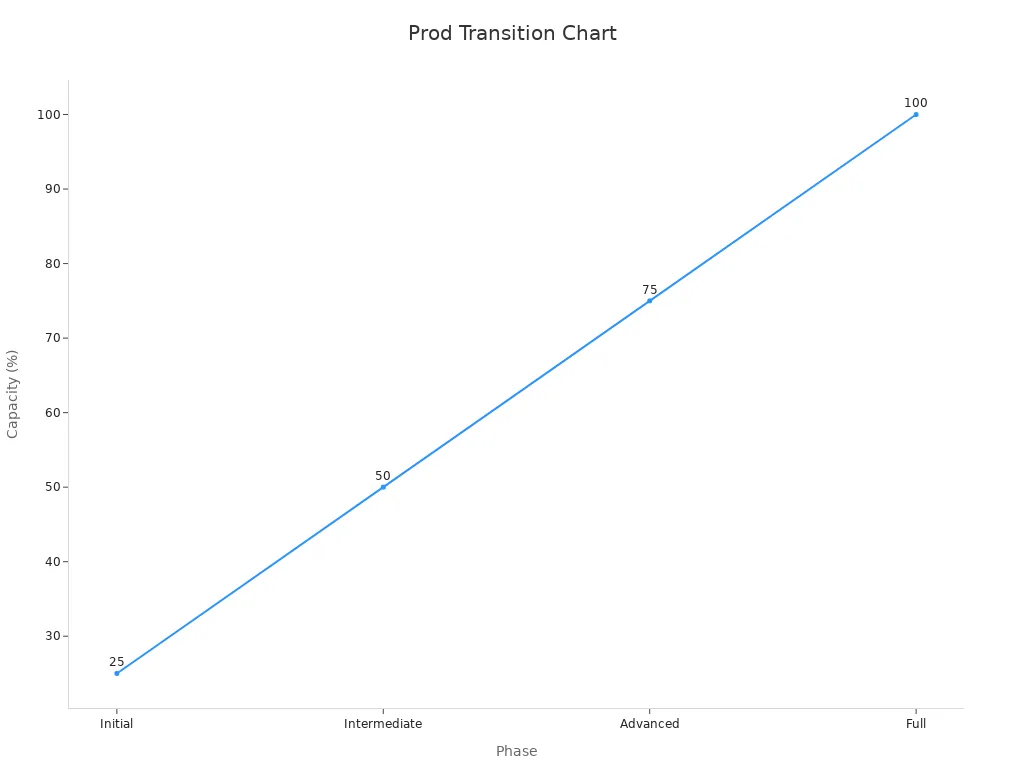
By investing in high-quality molds and rigorous testing, you can reduce production risks and ensure long-term success in full-scale manufacturing.
Small production runs are a vital step in the transition from prototyping to large-scale production. They allow you to test your product in a controlled environment, ensuring it meets quality standards before committing to full-scale manufacturing. By conducting these runs, you can identify potential production risks and address them early, saving time and resources.
One of the key benefits of small production runs is the ability to measure success through specific metrics. These metrics provide valuable insights into the efficiency and effectiveness of your manufacturing scale-up process. For example, tracking manufacturing cycle time helps you evaluate how quickly materials are converted into finished products. Similarly, monitoring the yield rate by production line ensures that most products are produced correctly on the first attempt. This minimizes waste and improves overall efficiency.
Here’s a breakdown of some critical metrics to monitor during small production runs:
| Metric | Description |
|---|---|
| Manufacturing Cycle Time | Measures the efficiency of production operations by tracking the time taken to convert materials into finished products. |
| Overall Equipment Effectiveness (OEE) | Combines machine availability, performance, and quality to assess overall production effectiveness. |
| Perfect Order Performance | Evaluates how well production and fulfillment meet customer expectations. |
| Supplier Quality Acceptance Rate | Indicates the effectiveness of supplier quality assurance processes. |
| Yield Rate by Production Line | Represents the percentage of products produced correctly on the first attempt, ready for delivery. |
By analyzing these metrics, you can refine your injection molding processes and ensure your product is ready for large-scale production. For instance, if the supplier quality acceptance rate is low, you may need to work closely with your suppliers to improve material quality. Similarly, a low yield rate might indicate design flaws or issues with your injection molds, which you can address before scaling up.
Small production runs also help you validate the durability and functionality of your product under real-world conditions. Testing your prototypes in small batches allows you to simulate the demands of full-scale manufacturing without the financial risks of mass production. This step ensures that your product performs consistently and meets customer expectations.
Incorporating small production runs into your manufacturing scale-up strategy reduces production risks and improves overall quality. It gives you the confidence to move forward with full-scale manufacturing, knowing that your product has been thoroughly tested and optimized.
Design errors in prototypes can lead to costly setbacks during scaling production. To avoid these issues, focus on refining your designs early in the prototyping phase. Start by conducting thorough design reviews. Collaborate with engineers and designers to identify potential flaws in your part design. Tools like computer-aided design (CAD) software can help you visualize and test your designs before moving to prototype injection molding.
Implementing Gemba Walks, a lean manufacturing practice, can also reduce errors. By observing the production process firsthand, you can identify inefficiencies and improve workflows. For example, companies that adopted Gemba Walks reported a 33% reduction in documentation errors and a 40% improvement in on-time delivery rates.
| Key Performance Indicator | Before Gemba Walks | After Gemba Walks |
|---|---|---|
| Equipment Setup Time (minutes) | 45 | 30 |
| Documentation Error Rate (%) | 5 | 1.5 |
| On-time Delivery Rate (%) | 75 | 92 |
Testing your prototypes under real-world conditions is another critical step. Rapid prototyping methods, such as 3D printing or prototype injection molding, allow you to create functional models quickly. These methods help you identify design flaws and refine your product for large-scale production. By addressing errors early, you reduce production risks and ensure a smoother transition to scaling up.
Tooling and mold creation play a pivotal role in scaling production efficiently. High-quality precision molds ensure consistent results and reduce waste during manufacturing. To optimize this process, consider using mold flow analysis. This technique allows engineers to simulate the injection molding process and identify potential issues like uneven filling or warping. By addressing these problems early, you can improve product quality and lower development costs.
For instance, a case study showed that optimizing mold production reduced costs by nearly 70%. The total mold production cost dropped from ¥13,352.4 to ¥4,056, while the mold production length decreased significantly.
| Description | Before Optimization (¥) | After Optimization (¥) | Cost Reduction (%) |
|---|---|---|---|
| Total Mold Production Cost | 13,352.4 | 4,056 | 69.6 |
| Total Mold Production Length | 97.77 m | 27.8 m | N/A |
To further enhance efficiency, streamline your tooling process by simplifying part designs. Complex features can increase mold production time and costs. Simplifying these features ensures faster mold creation and reduces the likelihood of defects. Additionally, investing in custom injection molding tools tailored to your product's specifications can improve efficiency and reduce production scaling risks.
Quality assurance is essential for mitigating risks during scaling up. Implementing robust quality assurance measures ensures your product meets customer expectations and performs reliably. Start by increasing test coverage. This involves creating test cases that cover all critical features of your product. Comprehensive testing helps identify potential issues before they escalate.
Monitoring key metrics like defect density and test pass/fail rates provides valuable insights into your product's quality. For example, tracking defect density helps you gauge the stability of your product over time. A lower defect density indicates higher quality and fewer production risks.
Regular audits also play a crucial role in quality assurance. By conducting audits, you can uncover opportunities for improvement and ensure compliance with industry standards. Lean manufacturing practices, such as minimizing waste and optimizing workflows, further enhance quality and reduce costs. Studies show that implementing lean manufacturing can reduce costs by 5% to 20% in the first year while improving quality metrics.
By combining these strategies, you can create a robust quality assurance framework that supports large-scale manufacturing. This approach not only reduces production risks but also ensures your product maintains high-quality standards as you scale.
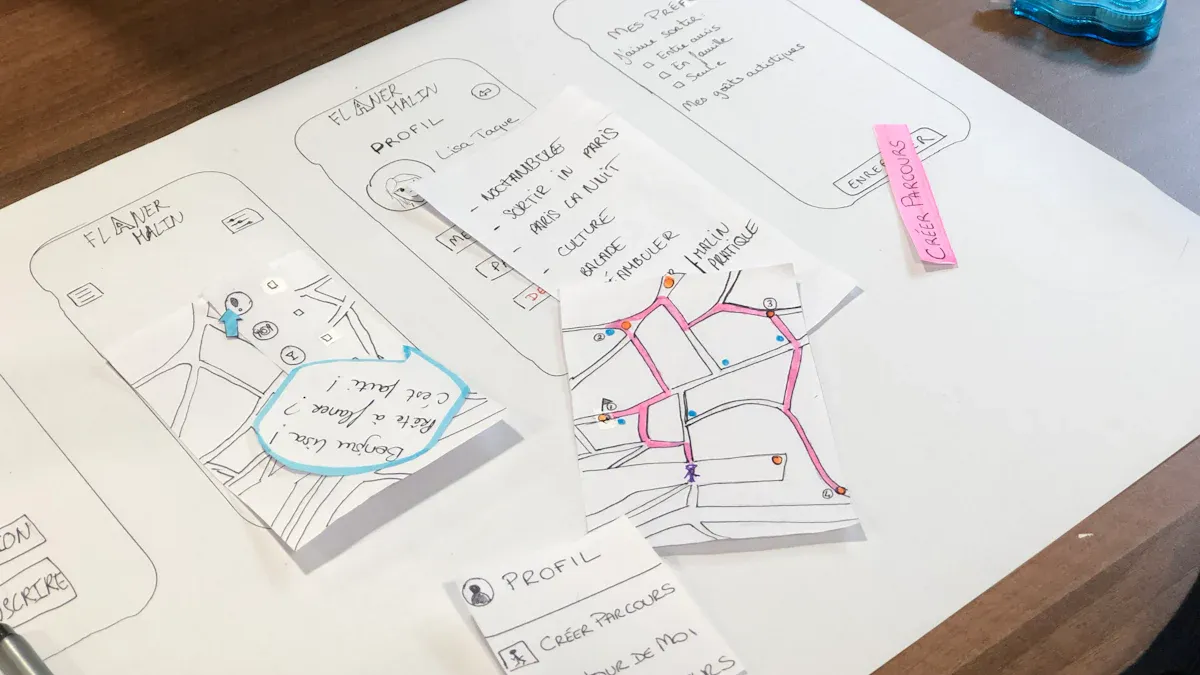
Selecting the right manufacturing partner is crucial for scaling production effectively. You need to evaluate their capabilities to ensure they can meet your requirements. Look for partners with a skilled workforce, as this ensures consistent production quality during peak demand. Assess their ability to manage resources efficiently, including materials, utilities, and equipment availability. A partner who minimizes waste and eliminates excess materials can help you reduce costs significantly.
Advanced Product Quality Planning (APQP) phases provide a structured approach to evaluating manufacturing capabilities. Here’s a breakdown of key deliverables across different phases:
| APQP Phase | Key Deliverables |
|---|---|
| Phase 3: Process Design and Development | - Packaging standards/specifications |
| - Product and process quality system review | |
| - Fully defined process flow chart | |
| - Production floor plan layout | |
| - Characteristics matrix | |
| - Process FMEA | |
| - Pre-launch control plan | |
| - Work instructions | |
| - Measurement systems analysis plan | |
| - Preliminary process capability study | |
| - Management support (staffing and training plan) | |
| Phase 4: Validation of Process and Product | - Significant production run |
| - Measurement system evaluation | |
| - Production part approval | |
| - Packaging evaluation | |
| - Control plan | |
| - Quality planning sign-off | |
| - Management support | |
| Phase 5: Production Launch, Assessment, and Continuous Improvement | - Reducing process variations |
| - Improved customer satisfaction | |
| - Improved delivery and service | |
| - Effective use of lessons learned and best practices |
By focusing on these deliverables, you can ensure your manufacturing partner is equipped to handle the complexities of scaling production.
Collaboration and communication play a vital role in successful production scaling. When you work closely with your manufacturing partner, you can address challenges more effectively. For example, collaborative efforts like those seen in the Department of Homeland Security's Data Stewardship Tactical Working Group demonstrate how teamwork can resolve complex issues. Similarly, the National Electronic Interstate Compact Enterprise (NEICE) case study highlights how communication streamlines processes and improves efficiency.
Cross-agency collaborations, such as those between the Bureau of Economic Analysis (BEA) and the Bureau of Labor Statistics (BLS), show the importance of clear communication in leveraging data and improving outcomes. These examples emphasize that strong partnerships and open dialogue can lead to better decision-making and smoother transitions during scaling.
Advanced tools and technologies can transform your production process, making it more efficient and adaptable. AI-powered tools streamline supplier selection, reducing screening time by 60% and improving match quality by 40%. Production planning tools powered by AI enhance scalability, reduce lead times, and improve overall efficiency.
Technological advancements like additive manufacturing, advanced robotics, and smart manufacturing offer significant cost savings. Here’s a look at their impact:
| Manufacturing Technology | Estimated Annual Cost Savings | Percentage Reduction in Production Costs |
|---|---|---|
| Additive manufacturing | $4.1 billion | 18.3% |
| Advanced robotics and automation | $40.1 billion | 5.3% |
| Roll-to-roll manufacturing | $400 million | 14.7% |
| Smart manufacturing | $57.4 billion | 3.2% |
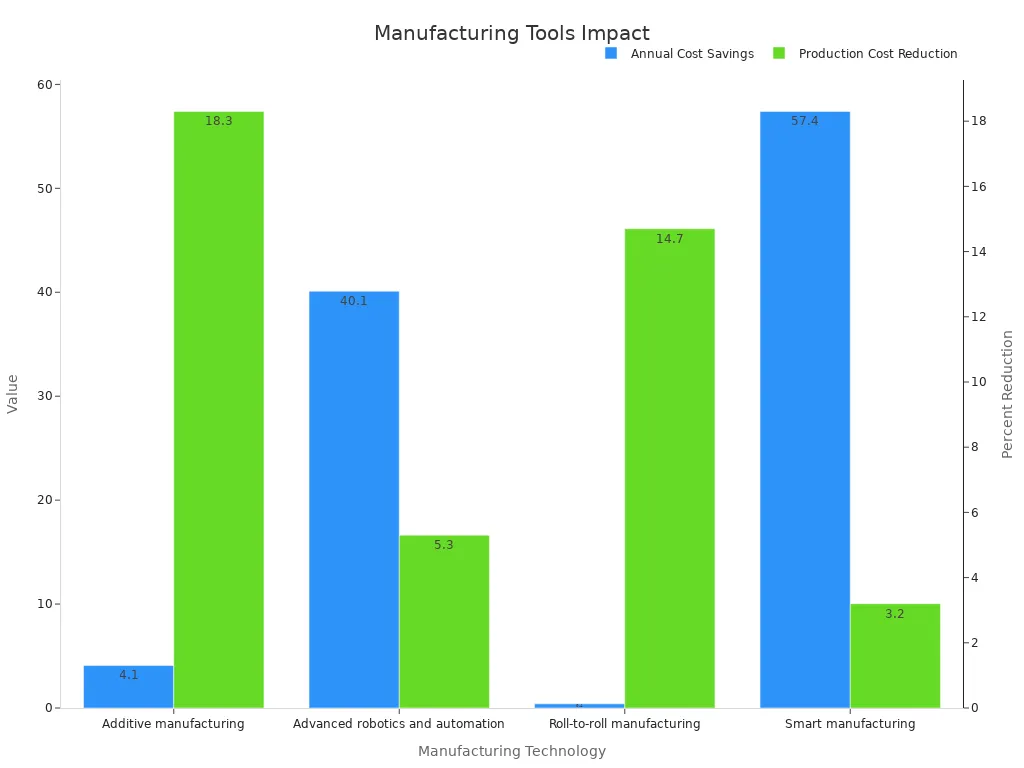
By leveraging these tools, you can optimize your production process and achieve scalability with reduced costs and improved efficiency.
Careful planning and execution are essential when scaling production. Structured methodologies, like Lean approaches, have proven effective in reducing time-to-market. For instance, a product strategy focused on predictive analytics successfully launched in just two quarters due to strategic planning. You can achieve similar results by dedicating time to collaborative data reviews and regular operational meetings. These practices ensure continuous improvement and prevent recurring issues.
To transition confidently, focus on refining designs, selecting durable materials, and validating quality through small production runs. Incorporate both structured and unstructured data, such as images and text, for complete business intelligence. This approach ensures your production process aligns with market demands and customer expectations.
Refining your design for manufacturability is crucial. Ensure your prototype is optimized for injection molding and large-scale production. This step minimizes errors, reduces costs, and ensures a smoother transition.
Conduct small production runs to test quality and identify potential issues. Use metrics like defect rates and cycle times to evaluate performance. Address problems early to avoid costly setbacks.
Materials impact durability, cost, and sustainability. Choose materials that meet performance requirements while staying cost-efficient. Testing materials under real-world conditions ensures reliability and customer satisfaction.
Small runs let you test your product in a controlled environment. They help identify flaws, validate durability, and refine processes. This ensures your product meets quality standards before mass production.
Evaluate their ability to scale production efficiently. Look for expertise in tooling, resource management, and quality assurance. A reliable partner ensures consistent production and reduces risks during scaling.